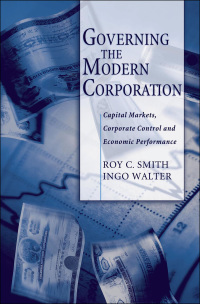Answered step by step
Verified Expert Solution
Question
1 Approved Answer
CASE 2 7 LINCOLN SPORTS EQUIPMENT CAPITAL BUDGETING This could be about the riskiest project we have ever considered, Sam Ledford remarked at a company
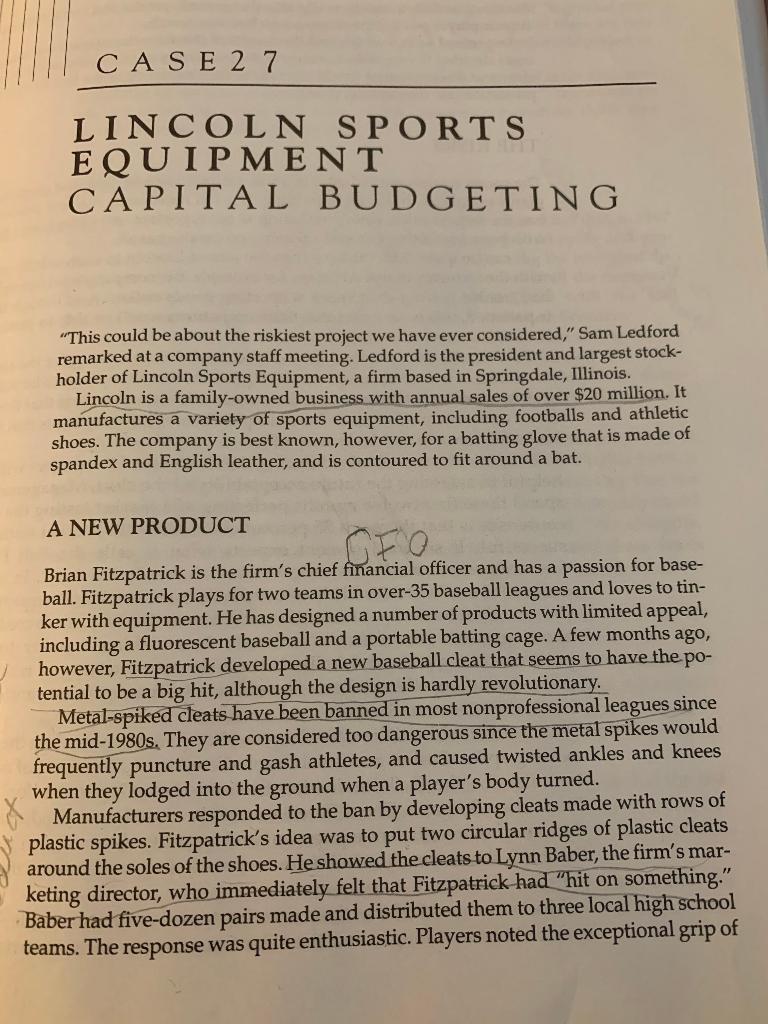
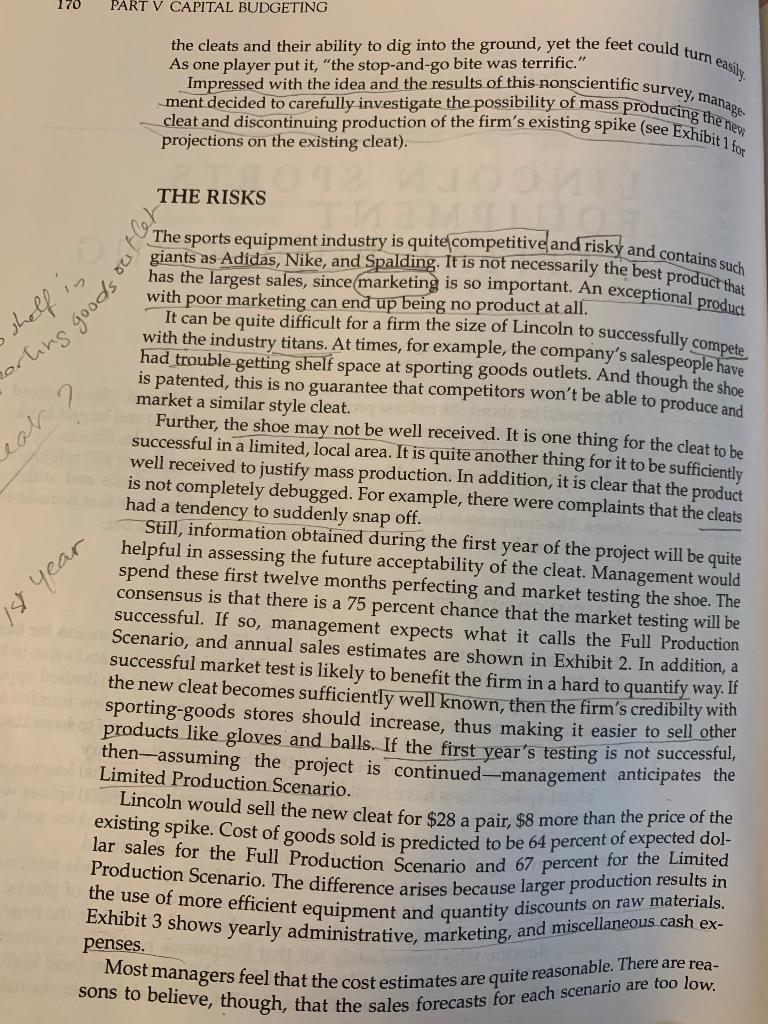
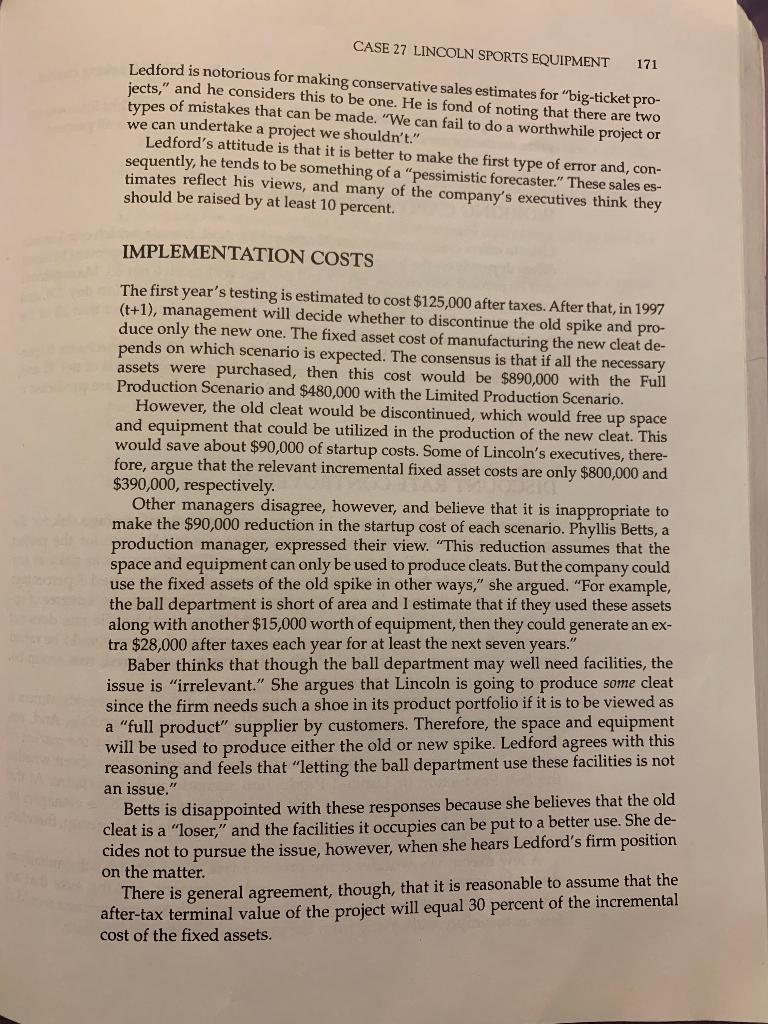
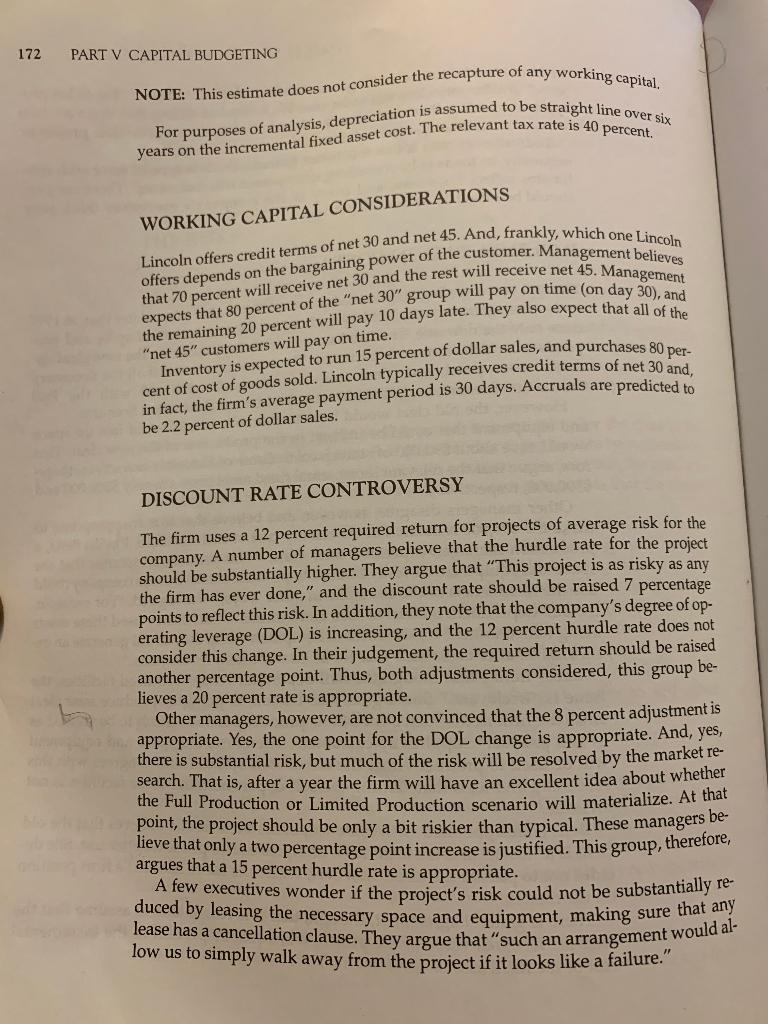
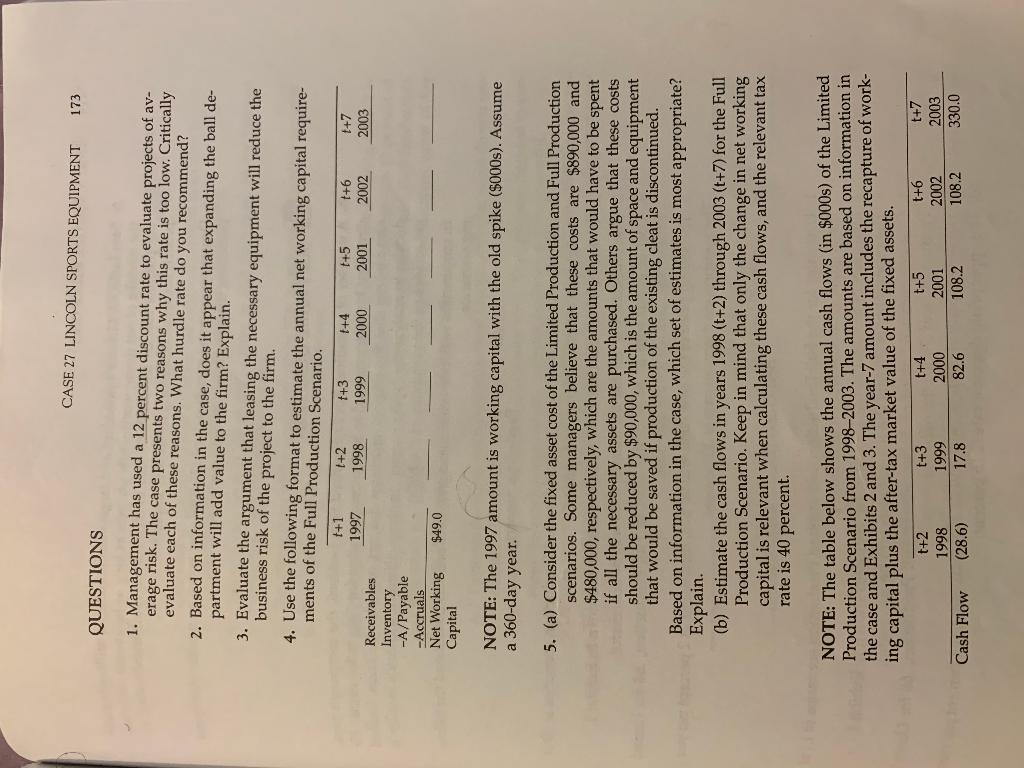
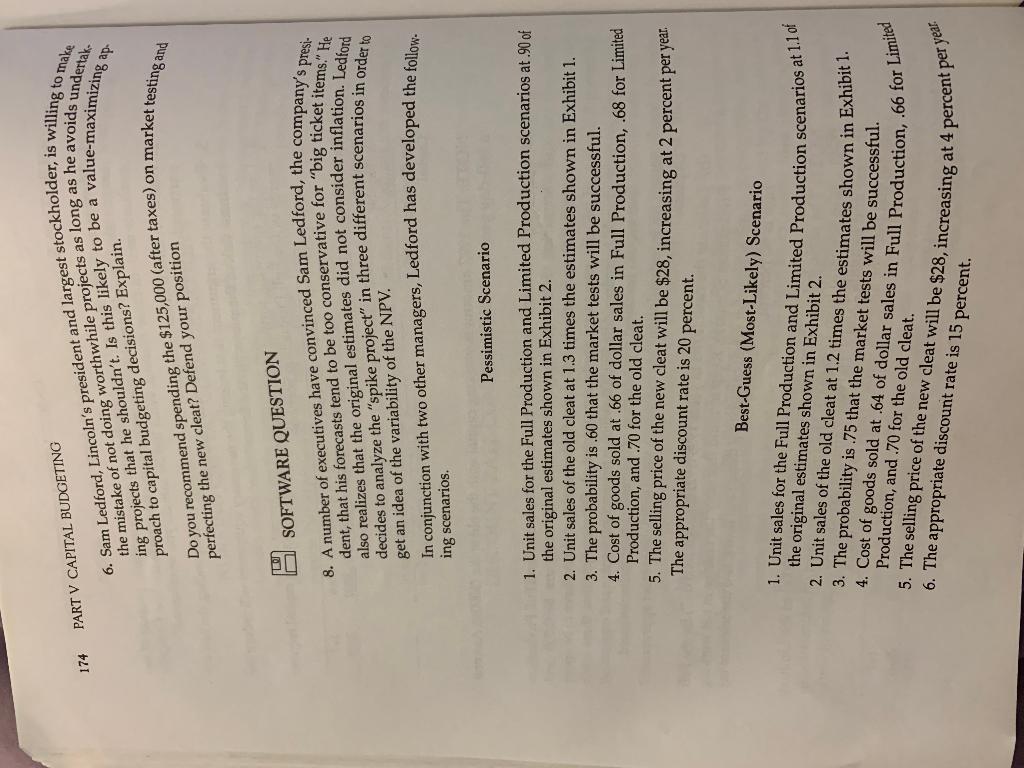
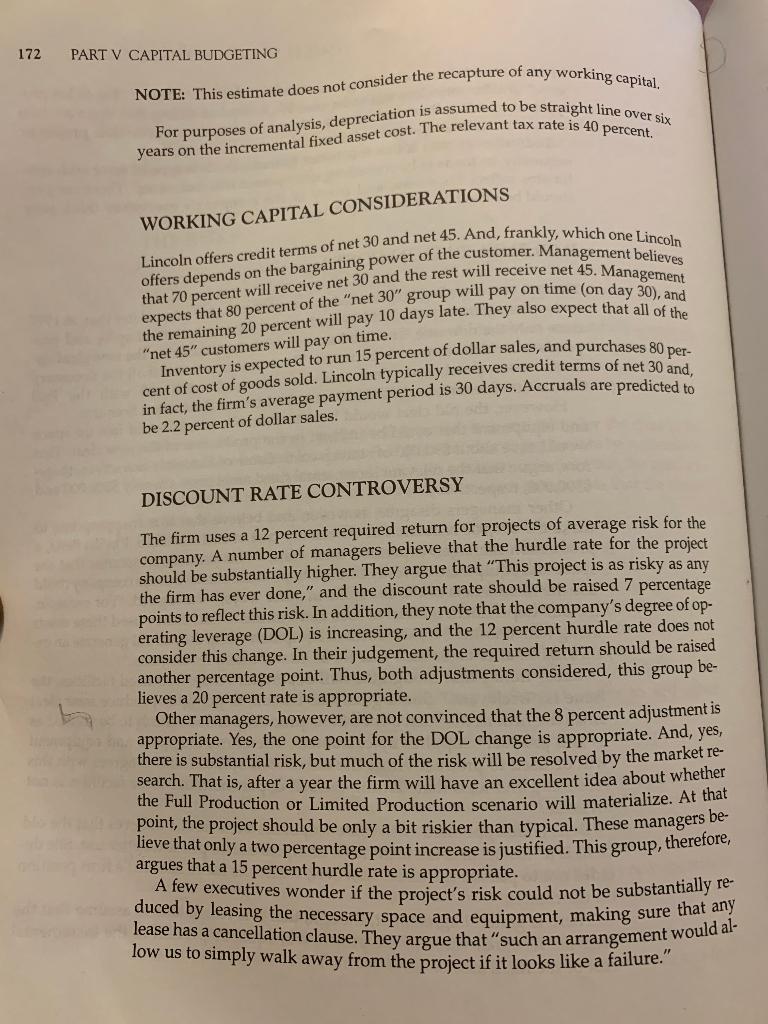
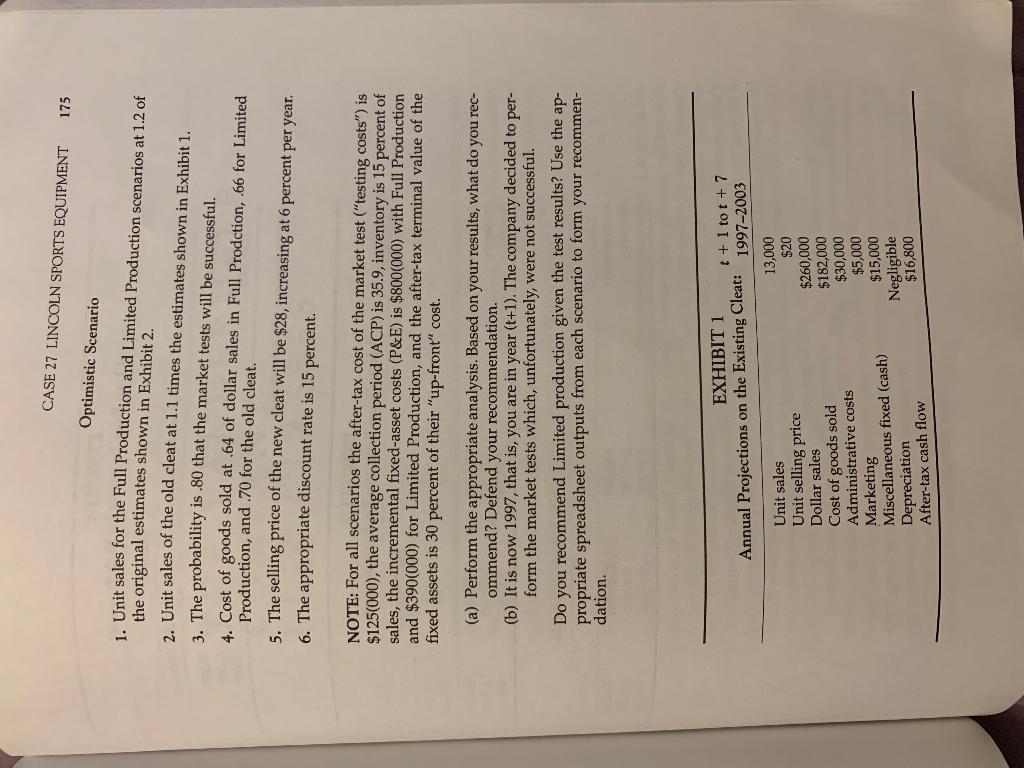

CASE 2 7 LINCOLN SPORTS EQUIPMENT CAPITAL BUDGETING "This could be about the riskiest project we have ever considered," Sam Ledford remarked at a company staff meeting. Ledford is the president and largest stock- holder of Lincoln Sports Equipment, a firm based in Springdale, Illinois. Lincoln is a family-owned business with annual sales of over $20 million. It manufactures a variety of sports equipment, including footballs and athletic shoes. The company is best known, however, for a batting glove that is made of spandex and English leather, and is contoured to around a bat. A NEW PRODUCT GEO Brian Fitzpatrick is the firm's chief financial officer and has a passion for base- ball. Fitzpatrick plays for two teams in over-35 baseball leagues and loves to tin- ker with equipment. He has designed a number of products with limited appeal, including a fluorescent baseball and a portable batting cage. A few months ago, however, Fitzpatrick developed a new baseball cleat that seems to have the po- tential to be a big hit, although the design is hardly revolutionary. Metal-spiked cleats have been banned in most nonprofessional leagues since the mid-1980s. They are considered too dangerous since the metal spikes would frequently puncture and gash athletes, and caused twisted ankles and knees when they lodged into the ground when a player's body turned. Manufacturers responded to the ban by developing cleats made with rows of plastic spikes. Fitzpatrick's idea was to put two circular ridges of plastic cleats around the soles of the shoes. He showed the cleats to Lynn Baber, the firm's mar- keting director, who immediately felt that Fitzpatrick had "hit on something." Baber had five-dozen pairs made and distributed them to three local high school teams. The response was quite enthusiastic. Players noted the exceptional grip of 170 PART V CAPITAL BUDGETING the cleats and their ability to dig into the ground, yet the feet could turn easily As one player put it, "the stop-and-go bite was terrific." ment decided to carefully investigate the possibility of mass producing the even Impressed with the idea and the results of this nonscientific survey, manage cleat and discontinuing production of the firm's existing spike (see Exhibit 1 for projections on the existing cleat). se spoob sur 2 1st year THE RISKS The sports equipment industry is quite competitive and risky and contains such giants as Adidas, Nike, and Spalding. It is not necessarily the best product that has the largest sales, since marketing is so important. An exceptional product with poor marketing can end up being no product at all. It can be quite difficult for a firm the size of Lincoln to successfully compete with the industry titans. At times, for example, the company's salespeople have had trouble getting shelf space at sporting goods outlets. And though the shoe is patented, this is no guarantee that competitors won't be able to produce and market a similar style cleat. Further, the shoe may not be well received. It is one thing for the cleat to be successful in a limited, local area. It is quite another thing for it to be sufficiently well received to justify mass production. In addition, it is clear that the product is not completely debugged. For example, there were complaints that the cleats had a tendency to suddenly snap off. Still, information obtained during the first year of the project will be quite helpful in assessing the future acceptability of the cleat. Management would spend these first twelve months perfecting and market testing the shoe. The consensus is that there is a 75 percent chance that the market testing will be successful. If so, management expects what it calls the Full Production Scenario, and annual sales estimates are shown in Exhibit 2. In addition, a successful market test is likely to benefit the firm in a hard to quantify way. If the new cleat becomes sufficiently well known, then the firm's credibilty with sporting-goods stores should increase, thus making it easier to sell other products like gloves and balls. If the first year's testing is not successful then-assuming the project is continued-management anticipates the Limited Production Scenario. Lincoln would sell the new cleat for $28 a pair, $8 more than the price of the existing spike. Cost of goods sold is predicted to be 64 percent of expected do lar sales for the Full Production Scenario and 67 percent for the Limited Production Scenario. The difference arises because larger production results in the use of more efficient equipment and quantity discounts on raw materials. Exhibit 3 shows yearly administrative, marketing, and miscellaneous cash ex- penses. Most managers feel that the cost estimates are quite reasonable. There are rea- sons to believe, though, that the sales forecasts for each scenario are too low. CASE 27 LINCOLN SPORTS EQUIPMENT 171 Ledford is notorious for making conservative sales estimates for "big-ticket pro- jects," and he considers this to be one. He is fond of noting that there are two types of mistakes that can be made. "We can fail to do a worthwhile project or we can undertake a project we shouldn't." Ledford's attitude is that it is better to make the first type of error and, con- sequently, he tends to be something of a pessimistic forecaster." These sales es- timates reflect his views, and many of the company's executives think they should be raised by at least 10 percent IMPLEMENTATION COSTS The first year's testing is estimated to cost $125,000 after taxes. After that, in 1997 (t+1), management will decide whether to discontinue the old spike and pro- duce only the new one. The fixed asset cost of manufacturing the new cleat de- pends on which scenario is expected. The consensus is that if all the necessary assets were purchased, then this cost would be $890,000 with the Full Production Scenario and $480,000 with the Limited Production Scenario. However, the old cleat would be discontinued, which would free up space and equipment that could be utilized in the production of the new cleat. This would save about $90,000 of startup costs. Some of Lincoln's executives, there- fore, argue that the relevant incremental fixed asset costs are only $800,000 and $390,000, respectively. Other managers disagree, however, and believe that it is inappropriate to make the $90,000 reduction in the startup cost of each scenario. Phyllis Betts, a production manager, expressed their view. "This reduction assumes that the space and equipment can only be used to produce cleats. But the company could use the fixed assets of the old spike in other ways," she argued. "For example, the ball department is short of area and I estimate that if they used these assets along with another $15,000 worth of equipment, then they could generate an ex- tra $28,000 after taxes each year for at least the next seven years." Baber thinks that though the ball department may well need facilities, the issue is "irrelevant." She argues that Lincoln is going to produce some cleat since the firm needs such a shoe in its product portfolio if it is to be viewed as a "full product" supplier by customers. Therefore, the space and equipment will be used to produce either the old or new spike. Ledford agrees with this reasoning and feels that "letting the ball department use these facilities is not an issue." Betts is disappointed with these responses because she believes that the old cleat is a "loser," and the facilities it occupies can be put to a better use. She de- cides not to pursue the issue, however, when she hears Ledford's firm position on the matter. There is general agreement, though, that it is reasonable to assume that the after-tax terminal value of the project will equal 30 percent of the incremental cost of the fixed assets. 172 PART V CAPITAL BUDGETING NOTE: This estimate does not consider the recapture of any working capital. For purposes of analysis, depreciation is assumed to be straight line over six years on the incremental fixed asset cost. The relevant tax rate is 40 percent. WORKING CAPITAL CONSIDERATIONS Lincoln offers credit terms of net 30 and net 45. And, frankly, which one Lincoln offers depends on the bargaining power of the customer. Management believes that 70 percent will receive net 30 and the rest will receive net 45. Management expects that 80 percent of the "net 30" group will pay on time (on day 30), and the remaining 20 percent will pay 10 days late. They also expect that all of the "net 45" customers will pay on time. cent of cost of goods sold. Lincoln typically receives credit terms of net 30 and, Inventory is expected to run 15 percent of dollar sales, and purchases 80 per- in fact, the firm's average payment period is 30 days. Accruals are predicted to be 2.2 percent of dollar sales. DISCOUNT RATE CONTROVERSY The firm uses a 12 percent required return for projects of average risk for the company. A number of managers believe that the hurdle rate for the project should be substantially higher. They argue that "This project is as risky as any the firm has ever done," and the discount rate should be raised 7 percentage points to reflect this risk. In addition, they note that the company's degree of op- erating leverage (DOL) is increasing, and the 12 percent hurdle rate does not consider this change. In their judgement, the required return should be raised another percentage point. Thus, both adjustments considered, this group be- lieves a 20 percent rate is appropriate. Other managers, however, are not convinced that the 8 percent adjustment is appropriate. Yes, the one point for the DOL change is appropriate. And, yes, there is substantial risk, but much of the risk will be resolved by the market re- search. That is, after a year the firm will have an excellent idea about whether the Full Production or Limited Production scenario will materialize. At that lieve that only a two percentage point increase is justified. This group, therefore, point , the project should be only a bit riskier than typical . These managers be argues that a 15 percent hurdle rate is appropriate. duced by leasing the necessary space and equipment, making sure that any A few executives wonder if the project's risk could not be substantially re low us to simply walk away from the project if it looks like a failure." CASE 27 LINCOLN SPORTS EQUIPMENT 173 QUESTIONS 1. Management has used a 12 percent discount rate to evaluate projects of av- erage risk. The case presents two reasons why this rate is too low. Critically evaluate each of these reasons. What hurdle rate do you recommend? 2. Based on information in the case, does it appear that expanding the ball de- partment will add value to the firm? Explain. 3. Evaluate the argument that leasing the necessary equipment will reduce the business risk of the project to the firm. 4. Use the following format to estimate the annual net working capital require ments of the Full Production Scenario. t+1 1+2 t3 I+4 t+5 t+6 t+7 1997 1998 1999 2000 2001 2002 2003 Receivables Inventory -A/Payable -Accruals Net Working $49.0 Capital NOTE: The 1997 amount is working capital with the old spike ($000s). Assume a 360-day year. 5. (a) Consider the fixed asset cost of the Limited Production and Full Production scenarios. Some managers believe that these costs are $890,000 and $480,000, respectively, which are the amounts that would have to be spent if all the necessary assets are purchased. Others argue that these costs should be reduced by $90,000, which is the amount of space and equipment that would be saved if production of the existing cleat is discontinued. Based on information in the case, which set of estimates is most appropriate? Explain (b) Estimate the cash flows in years 1998 (t+2) through 2003 (t+7) for the Full Production Scenario. Keep in mind that only the change in net working capital is relevant when calculating these cash flows, and the relevant tax rate is 40 percent. NOTE: The table below shows the annual cash flows (in $000s) of the Limited Production Scenario from 1998-2003. The amounts are based on information in the case and Exhibits 2 and 3. The year-7 amount includes the recapture of work- ing capital plus the after-tax market value of the fixed assets. t+2 t+3 t+4 t+5 t+6 t+7 1998 1999 2000 2001 2003 Cash Flow (28.6) 17.8 108.2 108.2 330.0 2002 82.6 PART V CAPITAL BUDGETING the mistake of not doing worthwhile projects as long as he avoids undertak 6. Sam Ledford, Lincoln's president and largest stockholder, is willing to make 174 ing projects that he shouldn't. Is this likely to be a proach to capital budgeting decisions? Explain. -. Do you recommend spending the $125,000 (after taxes) on market testing and perfecting the new cleat? Defend your position SOFTWARE QUESTION presi- dent, that his forecasts tend to be too conservative for "big ticket items." He also realizes that the original estimates did not consider inflation. Ledford decides to analyze the "spike project" in three different scenarios in order to get an idea of the variability of the NPV. In conjunction with two other managers, Ledford has developed the follow. ing scenarios. Pessimistic Scenario 1. Unit sales for the Full Production and Limited Production scenarios at 90 of the original estimates shown in Exhibit 2. 2. Unit sales of the old cleat at 1.3 times the estimates shown in Exhibit 1. 3. The probability is .60 that the market tests will be successful. 4. Cost of goods sold at.66 of dollar sales in Full Production, .68 for Limited Production, and .70 for the old cleat. 5. The selling price of the new cleat will be $28, increasing at 2 percent per year. The appropriate discount rate is 20 percent. Best-Guess (Most-Likely) Scenario 1. Unit sales for the Full Production and Limited Production scenarios at 1.1 of the original estimates shown in Exhibit 2. 2. Unit sales of the old cleat at 1.2 times the estimates shown in Exhibit 1. 3. The probability is .75 that the market tests will be successful. , and .70 for the old cleat. 4. Cost of goods sold at .64 of dollar sales in Full Production, .66 for Limited 5. The selling price of the new cleat will be $28, increasing at 4 percent per year. 6. The appropriate discount rate is 15 percent. 172 PART V CAPITAL BUDGETING NOTE: This estimate does not consider the recapture of any working capital. For purposes of analysis, depreciation is assumed to be straight line over six years on the incremental fixed asset cost. The relevant tax rate is 40 percent. WORKING CAPITAL CONSIDERATIONS Lincoln offers credit terms of net 30 and net 45. And, frankly, which one Lincoln offers depends on the bargaining power of the customer. Management believes that 70 percent will receive net 30 and the rest will receive net 45. Management expects that 80 percent of the "net 30" group will pay on time (on day 30), and the remaining 20 percent will pay 10 days late. They also expect that all of the "net 45" customers will pay on time. cent of cost of goods sold. Lincoln typically receives credit terms of net 30 and, Inventory is expected to run 15 percent of dollar sales, and purchases 80 per- in fact, the firm's average payment period is 30 days. Accruals are predicted to be 2.2 percent of dollar sales. DISCOUNT RATE CONTROVERSY The firm uses a 12 percent required return for projects of average risk for the company. A number of managers believe that the hurdle rate for the project should be substantially higher. They argue that "This project is as risky as any the firm has ever done," and the discount rate should be raised 7 percentage points to reflect this risk. In addition, they note that the company's degree of op- erating leverage (DOL) is increasing, and the 12 percent hurdle rate does not consider this change. In their judgement, the required return should be raised another percentage point. Thus, both adjustments considered, this group be- lieves a 20 percent rate is appropriate. Other managers, however, are not convinced that the 8 percent adjustment is appropriate. Yes, the one point for the DOL change is appropriate. And, yes, there is substantial risk, but much of the risk will be resolved by the market re- search. That is, after a year the firm will have an excellent idea about whether the Full Production or Limited Production scenario will materialize. At that lieve that only a two percentage point increase is justified. This group, therefore, point , the project should be only a bit riskier than typical . These managers be argues that a 15 percent hurdle rate is appropriate. duced by leasing the necessary space and equipment, making sure that any A few executives wonder if the project's risk could not be substantially re low us to simply walk away from the project if it looks like a failure." CASE 27 LINCOLN SPORTS EQUIPMENT 175 Optimistic Scenario 1. Unit sales for the Full Production and Limited Production scenarios at 1.2 of the original estimates shown in Exhibit 2. 2. Unit sales of the old cleat at 1.1 times the estimates shown in Exhibit 1. 3. The probability is .80 that the market tests will be successful. 4. Cost of goods sold at .64 of dollar sales in Full Prodction, .66 for Limited Production, and .70 for the old cleat. 5. The selling price of the new cleat will be $28, increasing at 6 percent per year. 6. The appropriate discount rate is 15 percent. NOTE: For all scenarios the after-tax cost of the market test ("testing costs") is $125(000), the average collection period (ACP) is 35.9, inventory is 15 percent of sales, the incremental fixed-asset costs (P&E) is $800(000) with Full Production and $390(000) for Limited Production, and the after-tax terminal value of the fixed assets is 30 percent of their "up-front" cost. (a) Perform the appropriate analysis. Based on your results, what do you rec- ommend? Defend your recommendation. (b) It is now 1997, that is, you are in year (t+1). The company decided to per- form the market tests which, unfortunately, were not successful. Do you recommend Limited production given the test results? Use the ap- propriate spreadsheet outputs from each scenario to form your recommen- dation. EXHIBIT 1 t + 1 tot +7 Annual Projections on the Existing Cleat: 1997-2003 Unit sales Unit selling price Dollar sales Cost of goods sold Administrative costs Marketing Miscellaneous fixed (cash) Depreciation After-tax cash flow 13,000 $20 $260,000 $182,000 $30,000 $5,000 $15,000 Negligible $16,800 V CAPITAL BUDGETING EXHIBIT 2 Annual Unit Sales Estimates for Each Scenario* Scenario Full Production Limited Production Year 70,000 80,000 110,000 20,000 25,000 30,000 1998 (t+2) 1999 2000-2003 Assumes the existing spike is discontinued. EXHIBIT 3 Selected Cost Estimates for Each Scenario Full Production t+3 t+2 1998 t+4 to t+7 2000-2003 1999 Administrative Marketing Miscellaneous fixed (cash) $156,800 $137,200 $ 70,600 $179,200 $112,000 $ 78,400 $246,400 $77,000 $ 80,100 Limited Production t+2 t+3 [+4 to 1+7 Administrative Marketing Miscellaneous fixed (cash) $ 84,000 $ 30,000 $ 39,200 $105,000 $ 30,000 $ 49,000 $100,800 $ 25,000 $ 50,400 CASE 2 7 LINCOLN SPORTS EQUIPMENT CAPITAL BUDGETING "This could be about the riskiest project we have ever considered," Sam Ledford remarked at a company staff meeting. Ledford is the president and largest stock- holder of Lincoln Sports Equipment, a firm based in Springdale, Illinois. Lincoln is a family-owned business with annual sales of over $20 million. It manufactures a variety of sports equipment, including footballs and athletic shoes. The company is best known, however, for a batting glove that is made of spandex and English leather, and is contoured to around a bat. A NEW PRODUCT GEO Brian Fitzpatrick is the firm's chief financial officer and has a passion for base- ball. Fitzpatrick plays for two teams in over-35 baseball leagues and loves to tin- ker with equipment. He has designed a number of products with limited appeal, including a fluorescent baseball and a portable batting cage. A few months ago, however, Fitzpatrick developed a new baseball cleat that seems to have the po- tential to be a big hit, although the design is hardly revolutionary. Metal-spiked cleats have been banned in most nonprofessional leagues since the mid-1980s. They are considered too dangerous since the metal spikes would frequently puncture and gash athletes, and caused twisted ankles and knees when they lodged into the ground when a player's body turned. Manufacturers responded to the ban by developing cleats made with rows of plastic spikes. Fitzpatrick's idea was to put two circular ridges of plastic cleats around the soles of the shoes. He showed the cleats to Lynn Baber, the firm's mar- keting director, who immediately felt that Fitzpatrick had "hit on something." Baber had five-dozen pairs made and distributed them to three local high school teams. The response was quite enthusiastic. Players noted the exceptional grip of 170 PART V CAPITAL BUDGETING the cleats and their ability to dig into the ground, yet the feet could turn easily As one player put it, "the stop-and-go bite was terrific." ment decided to carefully investigate the possibility of mass producing the even Impressed with the idea and the results of this nonscientific survey, manage cleat and discontinuing production of the firm's existing spike (see Exhibit 1 for projections on the existing cleat). se spoob sur 2 1st year THE RISKS The sports equipment industry is quite competitive and risky and contains such giants as Adidas, Nike, and Spalding. It is not necessarily the best product that has the largest sales, since marketing is so important. An exceptional product with poor marketing can end up being no product at all. It can be quite difficult for a firm the size of Lincoln to successfully compete with the industry titans. At times, for example, the company's salespeople have had trouble getting shelf space at sporting goods outlets. And though the shoe is patented, this is no guarantee that competitors won't be able to produce and market a similar style cleat. Further, the shoe may not be well received. It is one thing for the cleat to be successful in a limited, local area. It is quite another thing for it to be sufficiently well received to justify mass production. In addition, it is clear that the product is not completely debugged. For example, there were complaints that the cleats had a tendency to suddenly snap off. Still, information obtained during the first year of the project will be quite helpful in assessing the future acceptability of the cleat. Management would spend these first twelve months perfecting and market testing the shoe. The consensus is that there is a 75 percent chance that the market testing will be successful. If so, management expects what it calls the Full Production Scenario, and annual sales estimates are shown in Exhibit 2. In addition, a successful market test is likely to benefit the firm in a hard to quantify way. If the new cleat becomes sufficiently well known, then the firm's credibilty with sporting-goods stores should increase, thus making it easier to sell other products like gloves and balls. If the first year's testing is not successful then-assuming the project is continued-management anticipates the Limited Production Scenario. Lincoln would sell the new cleat for $28 a pair, $8 more than the price of the existing spike. Cost of goods sold is predicted to be 64 percent of expected do lar sales for the Full Production Scenario and 67 percent for the Limited Production Scenario. The difference arises because larger production results in the use of more efficient equipment and quantity discounts on raw materials. Exhibit 3 shows yearly administrative, marketing, and miscellaneous cash ex- penses. Most managers feel that the cost estimates are quite reasonable. There are rea- sons to believe, though, that the sales forecasts for each scenario are too low. CASE 27 LINCOLN SPORTS EQUIPMENT 171 Ledford is notorious for making conservative sales estimates for "big-ticket pro- jects," and he considers this to be one. He is fond of noting that there are two types of mistakes that can be made. "We can fail to do a worthwhile project or we can undertake a project we shouldn't." Ledford's attitude is that it is better to make the first type of error and, con- sequently, he tends to be something of a pessimistic forecaster." These sales es- timates reflect his views, and many of the company's executives think they should be raised by at least 10 percent IMPLEMENTATION COSTS The first year's testing is estimated to cost $125,000 after taxes. After that, in 1997 (t+1), management will decide whether to discontinue the old spike and pro- duce only the new one. The fixed asset cost of manufacturing the new cleat de- pends on which scenario is expected. The consensus is that if all the necessary assets were purchased, then this cost would be $890,000 with the Full Production Scenario and $480,000 with the Limited Production Scenario. However, the old cleat would be discontinued, which would free up space and equipment that could be utilized in the production of the new cleat. This would save about $90,000 of startup costs. Some of Lincoln's executives, there- fore, argue that the relevant incremental fixed asset costs are only $800,000 and $390,000, respectively. Other managers disagree, however, and believe that it is inappropriate to make the $90,000 reduction in the startup cost of each scenario. Phyllis Betts, a production manager, expressed their view. "This reduction assumes that the space and equipment can only be used to produce cleats. But the company could use the fixed assets of the old spike in other ways," she argued. "For example, the ball department is short of area and I estimate that if they used these assets along with another $15,000 worth of equipment, then they could generate an ex- tra $28,000 after taxes each year for at least the next seven years." Baber thinks that though the ball department may well need facilities, the issue is "irrelevant." She argues that Lincoln is going to produce some cleat since the firm needs such a shoe in its product portfolio if it is to be viewed as a "full product" supplier by customers. Therefore, the space and equipment will be used to produce either the old or new spike. Ledford agrees with this reasoning and feels that "letting the ball department use these facilities is not an issue." Betts is disappointed with these responses because she believes that the old cleat is a "loser," and the facilities it occupies can be put to a better use. She de- cides not to pursue the issue, however, when she hears Ledford's firm position on the matter. There is general agreement, though, that it is reasonable to assume that the after-tax terminal value of the project will equal 30 percent of the incremental cost of the fixed assets. 172 PART V CAPITAL BUDGETING NOTE: This estimate does not consider the recapture of any working capital. For purposes of analysis, depreciation is assumed to be straight line over six years on the incremental fixed asset cost. The relevant tax rate is 40 percent. WORKING CAPITAL CONSIDERATIONS Lincoln offers credit terms of net 30 and net 45. And, frankly, which one Lincoln offers depends on the bargaining power of the customer. Management believes that 70 percent will receive net 30 and the rest will receive net 45. Management expects that 80 percent of the "net 30" group will pay on time (on day 30), and the remaining 20 percent will pay 10 days late. They also expect that all of the "net 45" customers will pay on time. cent of cost of goods sold. Lincoln typically receives credit terms of net 30 and, Inventory is expected to run 15 percent of dollar sales, and purchases 80 per- in fact, the firm's average payment period is 30 days. Accruals are predicted to be 2.2 percent of dollar sales. DISCOUNT RATE CONTROVERSY The firm uses a 12 percent required return for projects of average risk for the company. A number of managers believe that the hurdle rate for the project should be substantially higher. They argue that "This project is as risky as any the firm has ever done," and the discount rate should be raised 7 percentage points to reflect this risk. In addition, they note that the company's degree of op- erating leverage (DOL) is increasing, and the 12 percent hurdle rate does not consider this change. In their judgement, the required return should be raised another percentage point. Thus, both adjustments considered, this group be- lieves a 20 percent rate is appropriate. Other managers, however, are not convinced that the 8 percent adjustment is appropriate. Yes, the one point for the DOL change is appropriate. And, yes, there is substantial risk, but much of the risk will be resolved by the market re- search. That is, after a year the firm will have an excellent idea about whether the Full Production or Limited Production scenario will materialize. At that lieve that only a two percentage point increase is justified. This group, therefore, point , the project should be only a bit riskier than typical . These managers be argues that a 15 percent hurdle rate is appropriate. duced by leasing the necessary space and equipment, making sure that any A few executives wonder if the project's risk could not be substantially re low us to simply walk away from the project if it looks like a failure." CASE 27 LINCOLN SPORTS EQUIPMENT 173 QUESTIONS 1. Management has used a 12 percent discount rate to evaluate projects of av- erage risk. The case presents two reasons why this rate is too low. Critically evaluate each of these reasons. What hurdle rate do you recommend? 2. Based on information in the case, does it appear that expanding the ball de- partment will add value to the firm? Explain. 3. Evaluate the argument that leasing the necessary equipment will reduce the business risk of the project to the firm. 4. Use the following format to estimate the annual net working capital require ments of the Full Production Scenario. t+1 1+2 t3 I+4 t+5 t+6 t+7 1997 1998 1999 2000 2001 2002 2003 Receivables Inventory -A/Payable -Accruals Net Working $49.0 Capital NOTE: The 1997 amount is working capital with the old spike ($000s). Assume a 360-day year. 5. (a) Consider the fixed asset cost of the Limited Production and Full Production scenarios. Some managers believe that these costs are $890,000 and $480,000, respectively, which are the amounts that would have to be spent if all the necessary assets are purchased. Others argue that these costs should be reduced by $90,000, which is the amount of space and equipment that would be saved if production of the existing cleat is discontinued. Based on information in the case, which set of estimates is most appropriate? Explain (b) Estimate the cash flows in years 1998 (t+2) through 2003 (t+7) for the Full Production Scenario. Keep in mind that only the change in net working capital is relevant when calculating these cash flows, and the relevant tax rate is 40 percent. NOTE: The table below shows the annual cash flows (in $000s) of the Limited Production Scenario from 1998-2003. The amounts are based on information in the case and Exhibits 2 and 3. The year-7 amount includes the recapture of work- ing capital plus the after-tax market value of the fixed assets. t+2 t+3 t+4 t+5 t+6 t+7 1998 1999 2000 2001 2003 Cash Flow (28.6) 17.8 108.2 108.2 330.0 2002 82.6 PART V CAPITAL BUDGETING the mistake of not doing worthwhile projects as long as he avoids undertak 6. Sam Ledford, Lincoln's president and largest stockholder, is willing to make 174 ing projects that he shouldn't. Is this likely to be a proach to capital budgeting decisions? Explain. -. Do you recommend spending the $125,000 (after taxes) on market testing and perfecting the new cleat? Defend your position SOFTWARE QUESTION presi- dent, that his forecasts tend to be too conservative for "big ticket items." He also realizes that the original estimates did not consider inflation. Ledford decides to analyze the "spike project" in three different scenarios in order to get an idea of the variability of the NPV. In conjunction with two other managers, Ledford has developed the follow. ing scenarios. Pessimistic Scenario 1. Unit sales for the Full Production and Limited Production scenarios at 90 of the original estimates shown in Exhibit 2. 2. Unit sales of the old cleat at 1.3 times the estimates shown in Exhibit 1. 3. The probability is .60 that the market tests will be successful. 4. Cost of goods sold at.66 of dollar sales in Full Production, .68 for Limited Production, and .70 for the old cleat. 5. The selling price of the new cleat will be $28, increasing at 2 percent per year. The appropriate discount rate is 20 percent. Best-Guess (Most-Likely) Scenario 1. Unit sales for the Full Production and Limited Production scenarios at 1.1 of the original estimates shown in Exhibit 2. 2. Unit sales of the old cleat at 1.2 times the estimates shown in Exhibit 1. 3. The probability is .75 that the market tests will be successful. , and .70 for the old cleat. 4. Cost of goods sold at .64 of dollar sales in Full Production, .66 for Limited 5. The selling price of the new cleat will be $28, increasing at 4 percent per year. 6. The appropriate discount rate is 15 percent. 172 PART V CAPITAL BUDGETING NOTE: This estimate does not consider the recapture of any working capital. For purposes of analysis, depreciation is assumed to be straight line over six years on the incremental fixed asset cost. The relevant tax rate is 40 percent. WORKING CAPITAL CONSIDERATIONS Lincoln offers credit terms of net 30 and net 45. And, frankly, which one Lincoln offers depends on the bargaining power of the customer. Management believes that 70 percent will receive net 30 and the rest will receive net 45. Management expects that 80 percent of the "net 30" group will pay on time (on day 30), and the remaining 20 percent will pay 10 days late. They also expect that all of the "net 45" customers will pay on time. cent of cost of goods sold. Lincoln typically receives credit terms of net 30 and, Inventory is expected to run 15 percent of dollar sales, and purchases 80 per- in fact, the firm's average payment period is 30 days. Accruals are predicted to be 2.2 percent of dollar sales. DISCOUNT RATE CONTROVERSY The firm uses a 12 percent required return for projects of average risk for the company. A number of managers believe that the hurdle rate for the project should be substantially higher. They argue that "This project is as risky as any the firm has ever done," and the discount rate should be raised 7 percentage points to reflect this risk. In addition, they note that the company's degree of op- erating leverage (DOL) is increasing, and the 12 percent hurdle rate does not consider this change. In their judgement, the required return should be raised another percentage point. Thus, both adjustments considered, this group be- lieves a 20 percent rate is appropriate. Other managers, however, are not convinced that the 8 percent adjustment is appropriate. Yes, the one point for the DOL change is appropriate. And, yes, there is substantial risk, but much of the risk will be resolved by the market re- search. That is, after a year the firm will have an excellent idea about whether the Full Production or Limited Production scenario will materialize. At that lieve that only a two percentage point increase is justified. This group, therefore, point , the project should be only a bit riskier than typical . These managers be argues that a 15 percent hurdle rate is appropriate. duced by leasing the necessary space and equipment, making sure that any A few executives wonder if the project's risk could not be substantially re low us to simply walk away from the project if it looks like a failure." CASE 27 LINCOLN SPORTS EQUIPMENT 175 Optimistic Scenario 1. Unit sales for the Full Production and Limited Production scenarios at 1.2 of the original estimates shown in Exhibit 2. 2. Unit sales of the old cleat at 1.1 times the estimates shown in Exhibit 1. 3. The probability is .80 that the market tests will be successful. 4. Cost of goods sold at .64 of dollar sales in Full Prodction, .66 for Limited Production, and .70 for the old cleat. 5. The selling price of the new cleat will be $28, increasing at 6 percent per year. 6. The appropriate discount rate is 15 percent. NOTE: For all scenarios the after-tax cost of the market test ("testing costs") is $125(000), the average collection period (ACP) is 35.9, inventory is 15 percent of sales, the incremental fixed-asset costs (P&E) is $800(000) with Full Production and $390(000) for Limited Production, and the after-tax terminal value of the fixed assets is 30 percent of their "up-front" cost. (a) Perform the appropriate analysis. Based on your results, what do you rec- ommend? Defend your recommendation. (b) It is now 1997, that is, you are in year (t+1). The company decided to per- form the market tests which, unfortunately, were not successful. Do you recommend Limited production given the test results? Use the ap- propriate spreadsheet outputs from each scenario to form your recommen- dation. EXHIBIT 1 t + 1 tot +7 Annual Projections on the Existing Cleat: 1997-2003 Unit sales Unit selling price Dollar sales Cost of goods sold Administrative costs Marketing Miscellaneous fixed (cash) Depreciation After-tax cash flow 13,000 $20 $260,000 $182,000 $30,000 $5,000 $15,000 Negligible $16,800 V CAPITAL BUDGETING EXHIBIT 2 Annual Unit Sales Estimates for Each Scenario* Scenario Full Production Limited Production Year 70,000 80,000 110,000 20,000 25,000 30,000 1998 (t+2) 1999 2000-2003 Assumes the existing spike is discontinued. EXHIBIT 3 Selected Cost Estimates for Each Scenario Full Production t+3 t+2 1998 t+4 to t+7 2000-2003 1999 Administrative Marketing Miscellaneous fixed (cash) $156,800 $137,200 $ 70,600 $179,200 $112,000 $ 78,400 $246,400 $77,000 $ 80,100 Limited Production t+2 t+3 [+4 to 1+7 Administrative Marketing Miscellaneous fixed (cash) $ 84,000 $ 30,000 $ 39,200 $105,000 $ 30,000 $ 49,000 $100,800 $ 25,000 $ 50,400
Step by Step Solution
There are 3 Steps involved in it
Step: 1

Get Instant Access to Expert-Tailored Solutions
See step-by-step solutions with expert insights and AI powered tools for academic success
Step: 2

Step: 3

Ace Your Homework with AI
Get the answers you need in no time with our AI-driven, step-by-step assistance
Get Started


